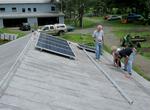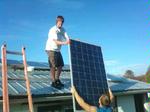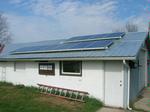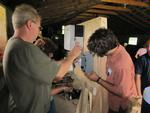News & Events
Notes from the Field Station: Let the Sun Shine!
Posted on Thursday, December 2, 2010
Eleven solar photovoltaic panels now adorn one-fourth of the south-facing roof of the shed at the Westminster College Field Station. On a bright, sunny day they generate enough electricity to support the lights, refrigerators and computers in the Nature Center. Should the day be extra bright and we add more panels, the electric meter will reverse. We are on the grid!
The solar project began in 1994 when a grant proposal was submitted to a foundation in Cleveland to launch the process of changing a farm into a Field Station. The grant provided funds to start renovating a barn into a Nature Center, purchase equipment to maintain the yard and study areas, build a boardwalk in wetland sections of the nature trail and . . . explore alternative energy resources.
The last-mentioned part of the proposal was also the lowest in priority and budget. At that point, solar cells were very expensive and no further efforts resulted in sufficient funds to install a system to convert the sun's energy to electricity. The residual funds from that grant, however, remained and then emerged again in 2008 as Dr. Ann Throckmorton, professor of biology, and other enthusiastic faculty explored green initiatives at the Field Station.
Those residual funds were not sufficient to go full speed into solar power but they provided seed money to bring a consultant on site and start moving us toward securing additional funds for solar. We could have contracted out the project and purchased, perhaps, only five panels and associated apparatus. But as the shakedown developed, we needed a new roof for the support of the panels on the shed and we wanted to have sufficient solar area to make the project worthwhile. That's when additional monies came in from individuals, departments and generous funds left with the College from two estates. So, with substantial donations of time and effort on the part of some faculty, students and local skilled workers, and the necessary permits, we proceeded with replacement of roof and "in house installation" of solar units.
Two workshops for College and community on alternative energy were recently held. In June, 25 community members and six faculty/staff of Westminster registered and showed up for theory and application of installing a solar system. In October, a second workshop brought eight local school teachers, five faculty/staff and three students to the Field Station for Sustainability in Motion, a new Westminster program that offered theory, kits and projects for spreading the word on alternative energy.
The 11 roof-mounted solar panels, each measuring 37 x 65 inches, are rated at 2.5 KwHours under optimal conditions. The system went "hot" during the second workshop. The grid-tied inverter that converts DC to AC and synchronizes the cycle frequency of our system with that of the utility company resides inside the shed with a window to the outside for observing a working system.
The wireless signal from the inverter is transmitted to a computer in the Nature Center where students and others can extract useful data. The data include Kw of energy per unit time, tracking of energy throughout the daylight hours and pounds of carbon dioxide that were saved from the atmosphere. Since throwing the switch on October 23 we have saved over 360 pounds of carbon dioxide from the atmosphere.
Future plans include continuing education workshops open to the College and community and adding up to 35 more solar panels to the roof of the shed. Eventually, the solar data could be available to the public through Westminster's website.
The Shell Oil Company has predicted that 50% of the world's energy will come from renewable resources by 2040. The Field Station is in the mix and we expect to eventually provide "all and more" of the electricity for our Field Station operations. Let the sun shine!
The chief players in the solar project have been Dr. Douglas Armstead, assistant professor of physics, Dr. Helen Boylan Funari, associate professor of chemistry, and John Edmiston (class of '07), a local certified electrician.
The grants and gifts that supported the new roof, eleven solar panels and an inverter for connection to the grid came from the 1525 Foundation in Cleveland, the Lucile Frey (class of '26) endowment, the estate of Lynn Aragon (class of '56), the Department of Biology, the Department of English and Public Relations, and Peggy Cox (professor of art at Westminster).
The grant sponsoring the workshop for the community came from the Drinko Center for Excellence in Teaching and Learning at Westminster. The workshop for teachers was sponsored by the Drinko Center and a grant from the Pennsylvania Department of Environmental Education.
Clarence Harms, Director
Field Station
(724) 946-6001
harmsc@westminster.edu




More Stories



